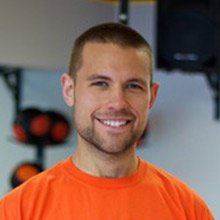By Aaron Boike, B.S. Kinesiology, ACE Certified Personal Trainer
Around the late fall every year, I get the question from a handful of fellow endurance athletes; “How can I best use my down time from running, bicycling, swimming etc. to perform better next season?” While I get that most of our readers here are not professional athletes, many of our clients at 3CLICK do participate in recreational runs, bicycle races and tours, triathlons, and even point to point swimming events. They work with their Trainers on everything from building core strength and stability, to more intricate muscular balance work to help reduce their risk of injury. The off-season is an important time of the year to get right, as it is a key time to build the foundation that you will be working with the next year when you begin your training again. While I always advocate taking 2-4 weeks easy following a hard training block, after that, it’s time to get back to business!
- Maintaining Your Base – While strength training is vital to optimizing your performance and decreasing your risk of injury, don’t give up your aerobic fitness by going back to dramatically on your training volume. To maintain cardiovascular fitness, you need to be doing aerobic training at least three times per week for 30 minutes or more. For more advanced athletes, I typically recommend they maintain a volume of 30-50% of their in season volume. For example, for a runner that does 30 miles per week, they would continue to run 15 during their off-season.
- Incorporating Strength Training – The benefits of strength training for those participating in endurance sports are not to be overlooked, and a solid program focused on building a strong foundation specific to the sport of choice is key. Most endurance athletes develop muscular imbalances related to their sports that can cause injury and hinder performance. For example, often times cyclists will develop strong and tight quads, and lack strength through the posterior chain muscles (primarily the hamstrings and glutes). In order to optimize performance and prevent overuse strain and injury, the posterior chain should be strengthened, and the hip flexors and quadriceps lengthened through mobility exercises. A strong focus on training the muscles of the midsection is also beneficial to all disciplines. We have a great set of videos on core exercises in our Exercise Library. Interestingly enough, research shows big benefits in lifting heavy for endurance athletes. Contrary to popular belief, doing compound movements (multi-joint exercises like Squats, Deadlifts, Swings) with heavy weight for low reps may yield a bigger benefit for endurance athletes than light weight exercises done for high repetitions. Also, utilizing Plyometric exercises (such as box jumps and jump squats) is beneficial in building power for endurance athletes, which can carry over to their choice sport.
- Adding In Mobility Work – All endurance sports do a number on the body due to the excessive use of target muscle groups. These muscle groups often become very stiff over time, and can result in poor form and injury if they are not targeted with mobility work. The foam roller is a great tool to help release the tension in your fascia, which is a connective tissue that covers the muscle itself. Much of the tension in the muscle results from stiffness of the fascia. Mobility drills exist for every joint and muscle in the body and can improve performance tremendously. I highly recommend Kelly Starrett’s book “Ready to Run” as a reference for mobility work for runners specifically.
